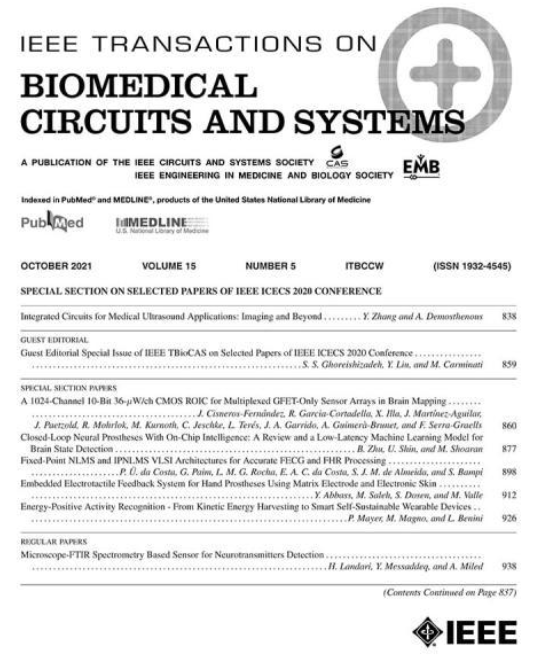A Figure-of-Merit for Design and Optimization of Inductive Power Transmission Links for Millimeter-Sized Biomedical Implants
IF 4.9
2区 医学
Q2 ENGINEERING, BIOMEDICAL
IEEE Transactions on Biomedical Circuits and Systems
Pub Date : 2016-04-25
DOI:10.1109/TBCAS.2016.2515541
引用次数: 69
Abstract
Power transmission efficiency (PTE) has been the key parameter for wireless power transmission (WPT) to biomedical implants with millimeter (mm) dimensions. It has been suggested that for mm-sized implants increasing the power carrier frequency (fp) of the WPT link to hundreds of MHz improves PTE. However, increasing fp significantly reduces the maximum allowable power that can be transmitted under the specific absorption rate (SAR) constraints. This paper presents a new figure-of-merit (FoM) and a design methodology for optimal WPT to mm-sized implants via inductive coupling by striking a balance between PTE and maximum delivered power under SAR constraints (PL,SAR). First, the optimal mm-sized receiver (Rx) coil geometry is identified for a wide range of fp to maximize the Rx coil quality factor (Q). Secondly, the optimal transmitter (Tx) coil geometry and fp are found to maximize the proposed FoM under a low-loss Rx matched-load condition. Finally, proper Tx coil and tissue spacing is identified based on FoM at the optimal fp. We demonstrate that fp in order of tens of MHz still offer higher PL,SAR and FoM, which is key in applications that demand high power such as optogenetics. An inductive link to power a 1 mm 3 implant was designed based on our FoM and verified through full-wave electromagnetic field simulations and measurements using de-embedding method. In our measurements, an Rx coil with 1 mm diameter, located 10 mm inside the tissue, achieved PTE and PL,SAR of 1.4% and 2.2 mW at fp of 20 MHz, respectively.毫米级生物医学植入物电感输电链路设计与优化的优值图
功率传输效率(PTE)是实现毫米级生物医学植入物无线功率传输的关键参数。研究表明,对于毫米尺寸的植入物,将WPT链路的功率载流子频率(fp)增加到数百MHz可以改善PTE,但是,增加fp会显著降低在特定吸收率(SAR)约束下可以传输的最大允许功率。本文提出了一种新的质量图(FoM)和设计方法,通过在SAR约束下的PTE和最大输出功率之间取得平衡,通过电感耦合实现最佳WPT到mm尺寸的植入物。首先,在较大的fp范围内,确定了最佳mm尺寸的接收器(Rx)线圈几何形状,以最大化Rx线圈质量因子(Q)。其次,在低损耗Rx匹配负载条件下,找到了最佳发射器(Tx)线圈几何形状和fp,以最大化所提出的FoM。最后,基于FoM在最优fp处确定了合适的Tx线圈和组织间距。我们证明,数量级为数十MHz的fp仍然提供更高的PL,SAR和FoM,这对于需要高功率的应用(如光遗传学)至关重要。基于我们的FoM设计了一种用于1mm3植入物供电的感应链路,并通过全波电磁场模拟和使用去嵌入方法的测量进行了验证。在我们的测量中,一个直径为1mm的Rx线圈位于组织内部10mm处,在fp为20mhz时,PTE和PL,SAR分别为1.4%和2.2 mW。
本文章由计算机程序翻译,如有差异,请以英文原文为准。
求助全文
约1分钟内获得全文
求助全文
来源期刊

IEEE Transactions on Biomedical Circuits and Systems
工程技术-工程:电子与电气
CiteScore
10.00
自引率
13.70%
发文量
174
审稿时长
3 months
期刊介绍:
The IEEE Transactions on Biomedical Circuits and Systems addresses areas at the crossroads of Circuits and Systems and Life Sciences. The main emphasis is on microelectronic issues in a wide range of applications found in life sciences, physical sciences and engineering. The primary goal of the journal is to bridge the unique scientific and technical activities of the Circuits and Systems Society to a wide variety of related areas such as: • Bioelectronics • Implantable and wearable electronics like cochlear and retinal prosthesis, motor control, etc. • Biotechnology sensor circuits, integrated systems, and networks • Micropower imaging technology • BioMEMS • Lab-on-chip Bio-nanotechnology • Organic Semiconductors • Biomedical Engineering • Genomics and Proteomics • Neuromorphic Engineering • Smart sensors • Low power micro- and nanoelectronics • Mixed-mode system-on-chip • Wireless technology • Gene circuits and molecular circuits • System biology • Brain science and engineering: such as neuro-informatics, neural prosthesis, cognitive engineering, brain computer interface • Healthcare: information technology for biomedical, epidemiology, and other related life science applications. General, theoretical, and application-oriented papers in the abovementioned technical areas with a Circuits and Systems perspective are encouraged to publish in TBioCAS. Of special interest are biomedical-oriented papers with a Circuits and Systems angle.
 求助内容:
求助内容: 应助结果提醒方式:
应助结果提醒方式:


